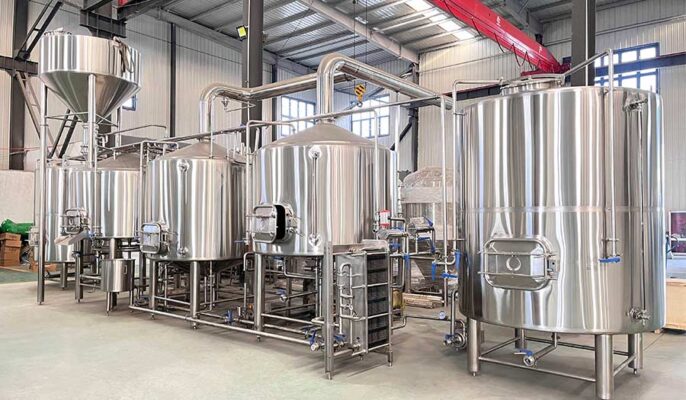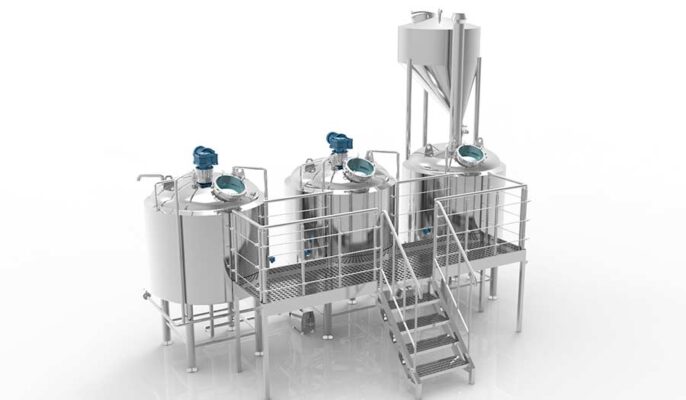In the brewing industry, the 3-vessel brewing system has become the first choice for many breweries and brewers as an efficient and flexible brewing solution. The system consists of three main components: wort barrel, lauter tun, and kettle. Each vessel plays a specific role in the brewing process, allowing for better control of the brewing process and producing a more consistent final product.
What is a 3 vessel brewing system?
A 3 vessel brewing system usually consists of three main components: a Mashing Tank, a Lautering Tank, and a Boiling Kettle. The workflow of a 3-vessel brewing system starts with raw material preparation and transforms malt into an alcoholic beverage through multiple steps such as mash, filtration, and boiling. The role and design of each container are crucial, and together they ensure the efficiency and stability of the brewing process. A 3-vessel brewing system is the ultimate equipment for professional home brewers. It consists of three separate kettles, each of which plays a vital role in the brewing process.
Mashing Tank
- Function: Mixing ground malt with hot water, converting starch into sugars through heating and stirring.
- Process: During mash, enzymes in the malt break down starch to form fermentable sugars. Controlling the temperature and time of this process is crucial to the flavor and quality of the final product.
Lautering Tank
- Function: Separating liquid wort from solid residue.
- Process: After mash, the wort needs to be separated through a filter kettle. The solid residue will remain at the bottom of the filter kettle, while the clear wort flows into the boiler for further processing.
Kokende Waterkoker
- Function: Boil the wort and add hops for final flavor adjustment.
- Process: In the boiler, the wort is heated to boiling point and hops are added to enhance the bitterness and aroma of the beer. Boiling also removes unnecessary components from the liquid, helping to form a clear beer.

Types of 3 Vessel Brewing Equipment Systems
- Homebrew Brewing Equipment: These are designed for hobbyists and homebrewers. They are more compact and can easily fit into a garage or dedicated brewing room. Homebrewing is a great starting point for many beer lovers, offering a hands-on, creative way to brew small amounts of beer in the comfort of their own homes.
- Nanobrewing Systems: A bridge between homebrewing and commercial brewing, nanobrewing systems have a larger capacity but are still suitable for smaller spaces such as cafes or experimental brewing labs. These systems are usually semi-automated and suitable for more frequent brewing.
- Microbrewing Equipment: Small breweries or craft breweries are larger than homebreweries, but still smaller than commercial breweries. They are highly automated and can be equipped with additional containers such as fermentation tanks.
- Commercial Brewery Systems: These systems are designed for large-scale production and are used by established breweries that produce large quantities of beer.
- Fully automated, equipped with advanced monitoring systems, and can usually be customized to the needs of the brewery. Commercial breweries are large-scale and supply beer to a wider market.
3 Vessel Brewing System Equipment Function
A 3 vessel brewing system is a piece of equipment used for commercial or home brewing, and its main function is to convert raw materials such as malt, wort and hops into beer.
Mashing Pot
- Wort Tub Starch Conversion: The wort tub is where the ground grains meet the hot water. This interaction activates enzymes in the malt, which convert the grains’ starches into fermentable sugars. This sweet liquid is called wort and is the basis of beer.
- Temperature Steps: Some brewing recipes require different temperatures to activate different enzymes at different stages of mashing. Modern wort tubs are equipped with advanced temperature controls to enable multi-step mashing.
Filter Tanks
- Separation of Wort from Grains: Once mashing is complete, the wort needs to be separated from the grain bed. The filter tank has slotted plates at the bottom that allow the liquid wort to pass through while retaining the solid grain bed.
- Rinsing: This is the process of flushing the grain bed with hot water to extract any remaining sugars. The filter tank facilitates rinsing by evenly distributing the hot water over the grain bed.
Waterkoker
- Boiling and adding hops: The collected wort is put into the boiling kettle and boiled. Hops are added at different stages of the boiling process to add bitterness, flavor, and aroma to the beer.
- Sterilization: Boiling wort has another key function: sterilization. Any harmful microorganisms are destroyed during the boiling process, ensuring clean subsequent fermentation.
- Whirlpool formation: Some boiling kettles have a whirlpool function, where the liquid circulates to form a vortex. This helps to settle solid particles in the center, making it easier to draw clear wort from the sides.

What does a 3-vessel brewing system cost?
The cost of a three-vessel brewing system can vary greatly depending on several factors. These factors include the system’s capacity, materials, level of automation, brand, and additional features. Whether you are a home brewer or a commercial brewer, understanding the cost structure is critical to making an informed decision.
|
SYSTEM CAPACITY |
PRIJSBEREIK |
|
5 gallons |
$500 – $1,500 |
|
10 Gallons |
$1,500 – $3,500 |
|
1 BBL (31 Gallons) |
$5.000 – $10.000 |
|
5 BBLs (155 Gallons) |
$20.000 - $40.000 |
|
10 BBLs (310 Gallons) |
$40.000 – $80.000 |
- Size/Capacity: Three-vessel brewing systems range from small homemade setups of a few gallons to large commercial systems capable of naturally producing thousands of gallons.
- Material: Stainless steel is the most commonly used material because it is durable, corrosion-resistant, and easy to clean. However, the quality and thickness of stainless steel vary, which can affect the price.
- Automation: Automated systems that include electronic controls, pumps, and motorized valves are more expensive than manual systems. But they also offer greater precision and ease of use.
- Additional Features: Some systems come with additional features, such as integrated heat exchangers, advanced temperature controls, and even grain mills. Each of these features can increase the cost.
- Installation and Training: Many manufacturers offer installation services and training courses. While this may increase the initial investment, it ensures that the system is set up correctly and that you or your team knows how to operate it effectively.
How to choose 3 vessel brewing equipment?
- Clear brewing goals: Consider the amount of beer you plan to brew. Home brewing usually chooses 20-200L, while commercial breweries require larger system sizes.
- Material selection: Most high-quality 3-vessel systems use stainless steel, which is corrosion-resistant, heat-resistant, and easy to clean. Some entry-level systems may use aluminum or other materials, which may be less expensive but not as durable as stainless steel.
- Space considerations: Size and space are crucial. Measure your brewing space to determine the maximum system size it can accommodate. Remember to consider additional space for moving, storage, and other brewing accessories.
- Customization options: Some manufacturers offer customization options. From adding additional ports for additional sensors to personalizing the appearance of the system, these options can make your brewing system truly unique.
- Maintenance: Regular maintenance is essential to the lifespan and performance of your brewing system. Choose a system that is easy to clean and maintain.
- Warranty and support: Consider the warranty and after-sales support provided by the manufacturer. A good warranty shows that the manufacturer is confident in its products, and strong support ensures that you get help if problems arise.
- Supplier’s reputation: Pay special attention to the reputation of your supplier; other brewers can provide insights into related issues.
FAQ
What is a 3 vessel brewing system?
A 3 vessel brewing system is a type of equipment used to brew beer that includes three main vessels: Mashing Kettle, Lauder Tun, and Boil Kettle. The functions of each vessel are mashing, filtering, and boiling.
What is the price range of a 3 vessel brewing system?
The specific price depends on the specific brewing needs, and here is a rough estimate of the amount:
- Entry-level system: $300-$800
- Mid-range system: $800-$2,000
- High-end system: $2,000-$5,000 or more
What is the difference between a 3 vessel brewing system and a single-pot system?
A 3 vessel system has three dedicated vessels for mashing, filtering, and boiling, providing higher control accuracy and better efficiency. A single-pot system (such as a single-pot mashing system) concentrates these steps in one pot, which is simpler to operate but may not be as efficient and controllable as a 3-vessel system.
Do I need to install a cooling device?
Yes, a cooling device (such as a cooling coil or a spray cooler) is very important to quickly cool the boiled wort to the required temperature for fermentation to avoid bacterial contamination and overheating.




